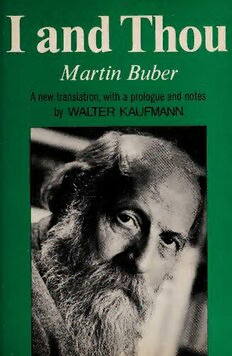Table Of ContentDigitized by the Internet Archive
in 2018 with funding from
Kahle/Austin Foundation
https://archive.org/details/ithou00bube_0
I AND THOU
t.
I AND THOU
Martin Buber
A NEW TRANSLATION
WITH A PROLOGUE “I AND YOU”
AND NOTES
BY
WALTER KAUFMANN
CHARLES SCRIBNER’S SONS
NEW YORK
Translation
Copyright © Charles Scribner’s Sons
1970
Introduction
Copyright © Walter Kaufmann
1970
All rights reserved. No part of this book
may be reproduced in any form without the
permission of Charles Scribner’s Sons.
192123252729 C/C 302826242220
23252729 C/P 30282624
Printed in the United States of America
Library of Congress Catalog Card Number
72-123845
SBN - (trade cloth)
684 10044-4
SBN - (trade paper, SL)
684 71725-5
CONTENTS
Acknowledgments 1
Key 5
I AND YOU: A PROLOGUE by Walter Kaufmann 7
A Plan Martin Buber Abandoned 49
Martin Buber’s I AND THOU 51
First Part 53
Second Part 87
Third Part 123
Afterword 169
Glossary 183
ACKNOWLEDGMENTS
The present volume owes its existence to Rafael Buber.
In June 1969 he phoned me from Boston, explained that
he was Martin Buber’s son, and asked whether he could
come to see me in Princeton. We had never met, and he
offered no explanation; but when he came a few days later,
there was an instant rapport, coupled with an intriguing
lack of directness. He told me of his desire for a new
English translation of Ich und Du and asked my counsel.
I recalled how his father had told me that he considered
Ronald Gregor Smith, who had done I and Thou, by far his
best translator. Rafael insisted that those whose advice he
valued were agreed that the old version had to be replaced.
I myself had attacked the use of “thou” instead of “you”
in print, but at this point did not let on that I did not like
the old translation. Instead I pointed out how nearly un¬
translatable the book was. Rafael did not protest, but his
mind was made up, and he wanted my help. I mentioned
names. They would not do: the new version had to be done
by someone who had been close to his father; and he had
come a long way and did not want to return home to Israel
without having accomplished this mission. Now I insisted
that the book really was untranslatable, and that all one
2 I AND THOU
could do was to add notes, explaining plays on words—and
I gave an example. Instant agreement: that was fine—a
translation with notes. He wanted me to do it, however I
chose to do it, and it was clear that I would have his full
cooperation.
This I got. That unforgettable day in my study, and later
on in the garden, was the fourth anniversary of Martin
Buber’s death. I hesitated for a few days, but the challenge
proved irresistible. Thus I was led back into another dia¬
logue with Martin Buber, well over thirty years after I had
first seen and heard him in Lehnitz (between Berlin and
Oranienburg) where he had come with Ernst Simon at his
side to teach young people Bibel lesen—to read the Bible.
In the summer of 1969 I visited the Buber Archive in
Jerusalem and had a look at the handwritten manuscript of
Ich und Du and at Buber’s correspondence with Ronald
Gregor Smith. I asked for copies of the complete manu¬
script and of all pages on which Buber had commented on
points of translation. The material was promptly sent to
me and turned out to be of considerable interest. (See the
Key, below.) Having noticed some discrepancies between
the first edition of the book and the later editions, I asked
Rafael Buber whether he had a record of the variants. He
did not, but made a list himself, by hand, for my use.
Both from him and from Mrs. Margot Cohn, who for
decades was Buber’s secretary and who now works full¬
time in the Archive, I have encountered not only kindness
and cooperation at every point but the spirit of friendship.
I have been equally fortunate with my undergraduate
research assistant at Princeton, Richard L. Smith ’70. He
had read the original translation of I and Thou three times
before he began to assist me, and he loved the book. There
is no accounting for how many times he has read it now,
comparing the new version with the old one, raising ques-

